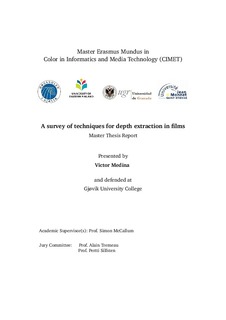| dc.description.abstract | The proliferation of 3D-enabled displays in the last decade is increasing the demand for 3D content. There are several approaches to produce 3D content: Live camera capture, Computergenerated content and 2D-to-3D conversion. Creating 3D content directly from cameras requires the use of expensive equipment and facilities, so many content providers prefer to create their material in 2D, and then convert them into 3D. Similarly, these conversion techniques can also be used to convert already existing 2D material (movies, cartoons, etc.) into 3D, so they can take advantage of the new display technologies. The conversion of films from 2D to 3D requires three stages: Assigning depth to each picture element (pixel), generating a stereo pair of images, and filling in missing information. One of the most time consuming parts of this process is assigning a depth value for each pixel of each image, as this process is usually done manually. Two of the open research questions related to converting 2D content are the integration of multiple depth cues and the automation of the conversion process. In this project we present an automatic process that can successfully estimate the depth range of a film scene, as well as the number of depth planes and their relative positions in relation to that range. In addition, we propose a new method to evaluate the quality of the results by comparing them with depth map data generated with the Microsoft Kinect’s depth sensor. | no_NO |
